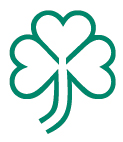
ST. PATRICK'S DAY PARADE: ITS HISTORY & THE PARADE 2011
FIFTH AVE. FROM 44TH ST. TO 86TH ST.

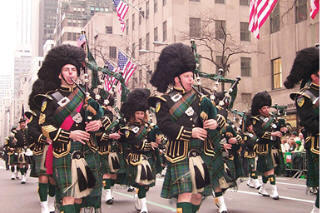
You don't have to be Irish to get a kiss at New York City's famous St. Patrick's Day Parade. The parade, which was first held on March 17, 1762, is the City's oldest and largest. Officiated by the archbishop of New York, the parade celebrates Irish culture and the Catholic faith. Cars, floats and other vehicles are not allowed. The parade begins at 11am led by members of the 165th "Fighting Irish" Infantry.
History of St. Patrick's Day Parade
Christopher Cahill, Editor in Chief,
The Recorder: The Journal of THE AMERICAN IRISH HISTORICAL SOCIETY
The first recorded Saint Patrick's Day Parade in New York City took place fourteen years before the signing of the Declaration of Independence. On March 17, 1762 a small group of Irish New Yorkers marched to the inn of one John Marshall "at Mount Pleasant, near the College" (near the present-day intersection of Barclay and Church streets in lower Manhattan) where the day would be celebrated. Little else is known about that early parade, and in years earlier still there may have been similar marches and gatherings that have escaped record, but whatever else those solemn revelers accomplished on that late winter's day close on two and a half centuries ago, they began, or can be credited with beginning, here in New York, an annual celebration which has continued without interruption ever since.
It is only appropriate, given the uncertain record of the life and times of St. Patrick himself, that the early instances of New York's St. Patrick's Day celebrations are somewhat lost in the mists of unrecorded history. As the late Liam de Paor wrote in his classic study, Saint Patrick's World:
No actual manuscript of any find written in Ireland in that century now survives. There is virtually not a single Irish artifact in a museum or a single monument in the field of which an archeologist could say with full confidence that it was made in the fifth century.
And yet Patrick's writings, as we know them from later copies, survive today and continue to instruct and delight; his great work of conversion survives, immeasurably woven into the fabric of Irish life and culture and, consequently, into the cultures of all those many nations to which the Irish have emigrated over the centuries.
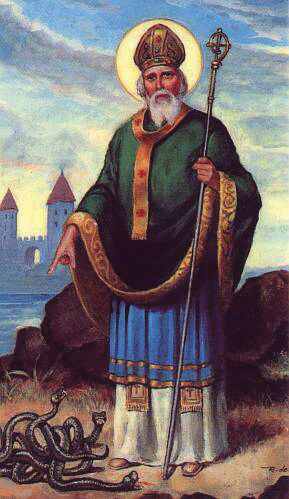
Pre-revolutionary Manhattan may not be as distant and unrecoverable as fifth century Ireland, but it is far enough away, and the records of the life lived by those Irish who were here already at that time are sketchy at best, are more often blank. There is, again, a certain appropriateness to this obscurity, to our inability to bring that past time into satisfactory focus. For those early New York marchers were not only beginning the tradition we continue today, they were themselves carrying on a much older tradition, one which they had brought with them, as perhaps their sole precious possession, to this country and this city. To quote once more from Liam de Paor's splendid work of scholarship:
From the seventh century onward, Patrick was regarded as pre-eminent among Ireland's early saints. His feast day, as a kind of national day, was already being celebrated by the Irish in Europe in the ninth and tenth centuries. In later times he become more and more widely known as the patron of Ireland. The crowds who march up Fifth Avenue in New York on March 17 each year may not know a great deal about him, but in honoring his memory they follow a very ancient tradition.
So let it be said, with all Irish humility, that not only does New York's Saint Patrick's Day Parade predate the independence of the United States, it can even be traced, by extension, back nearly as far as St. Brendan the Navigator's discovery of the American New World.
St. Patrick's Day is a uniquely Irish holiday, and yet it is celebrated in more countries around the world than any other national holiday. There are St. Patrick's celebrations in Dublin, Tokyo, Melbourne, Kuala Lumpur, New Orleans, Savannah, Toronto, Auckland, Chicago and Montreal, to name a few/and the day must be a pleasure in all of those places, for those unlucky enough not to be in New York City. This geographical spread is less surprising when one considers the prolific dispersion undertaken by the Irish, through choice or necessity, over the past three centuries. There is no corner of the globe the Irish have left unvisited, and there is none where they have settled that has been more deeply shaped by them than has New York.
There's no denying the preeminence of New York's St. Patrick's Day Parade. Last year over 400 marching bands, Pipe S Drums Corps, County Societies, police, firefighters, and scores of others made up the 200,000 marchers who followed the course from St. Patrick's Cathedral up Fifth Avenue to 86th Street. Over 2,000,000 spectators lined the sidewalks to watch and cheer. These vast numbers are a far cry from the celebrations of the early years, when the parades here were chiefly military in nature, with the small groups of marchers drawn largely from Irish members of the local militia. It was not until the 1820s that the sponsorship of the parade (or of the various parades, rather, as there used to be more than a few) began to be undertaken by such social and fraternal organizations as the Hibernian Universal Benevolent Society and the Independent Sons of Erin.
It was in 1853 that the Ancient Order of Hibernians, for many years now the parade's principal sponsor, first marched. From that time onward, the time of the Great Famine and the massive increase in Irish emigration to America, the parade has been a fixture in the city's social, political, and cultural life. If it was at first intended "to show the newly arrived immigrants as respectable citizens worthy of esteem in American society" [to quote John T. Ridge, the author of a fine history of the parade], it soon became an assertion of the political strength and centrality of the Irish in New York.
Throughout its history, the parade, mindful of its religious origins and impulse, has remained more understated than some, with its row after row of marchers and riders unaccompanied by floats or amplified music. It is still what Thomas Francis Meagher, later to be a hero of the American Civil War, called it in 1855: "a festival of memory" It is a festival of religious memory, of cultural memory, and of familial memory. Though it is Patrick's day that we celebrate, it is also surely our own. For each marcher and each spectator, even those who are Irish only for the day, has his or her own family history, a history which, this country being what it is, this world being what it is, is likely to tell a tale of exile and dispossession, of struggle and success, of decline and rebirth and continuance.
It is well known that, during the period of conversion, Christian holidays were grafted onto existing pagan periods of celebration, which they were intended to, and did in fact, replace or subsume. St. Patrick's Day must cover and continue some ancient festival celebrating spring's arrival or approach, for it does always seem to mark a turning point in the year, whether of one season dying or another coming to life. And for all the religious solemnity of the occasion, a certain pagan Celtic joie de vim is not too difficult to detect in the atmosphere.
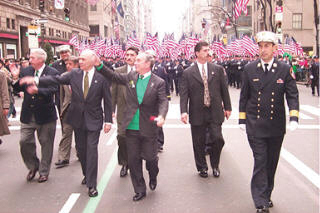
With this year's parade, we have entered the third millennium in which St. Patrick's Day will be celebrated by the Irish and their adherents. I am writing this in the last days of the second millennium, in the middle of winter looking forward to the start of spring. It will be good to see the crowds line the avenue, as they do each year on March 17, and to see this year's crowd larger even than the last. It will be good to see the familiar bands and banners -"The Fighting 69'", "the 42"" Infantry with their Irish wolfhounds, the County Societies, the parochial, high school, and college marching bands - and to see the year's new faces. Some years, pleasantly, it can seem as though the day will have no end to it. As an Irish American novelist once wrote, describing a mid-century parade, "The Irish swept endlessly up Fifth Avenue as if replenished hourly by fresh shiploads of immigrants." May they, may we, do so always.
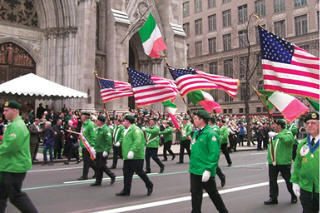
2011 New York City Saint Patrick's Day Parade
Thursday, March 17th, 2010 11:00 a.m. Starting @ 44th Street and Fifth Avenue
Congratulation to the 2011 Grand MarshalMary Higgins Clark
Now Marching for the 250th Consecutive Year Up Fifth Avenue in New York City - Marched for the first time on March 17, 1762 - Sixteen Years before the Declaration of Independence was adopted.
The Parade will be reviewed from the steps of Saint Patrick's Cathedral by His Eminence the Cardinal Archbishop of New York. It will also be reviewed from the Official Reviewing Stand at 64th Street and 5th Avenue.
The parade marches up 5th Avenue, clan by clan, from 44th to 86th streets starting at 11am on St. Patrick's Day.
At around midday, the parade will pause for one minute as Cardinal Egan leads participants in a prayer from the reviewing stand at 64th Street and 5th Avenue. It's a reminder that St. Paddy's Day is a religious holiday back in the motherland even though, for New Yorkers, it's a chance to party hardy like any good Irishman. There probably isn't a bigger day when green face paint, green food coloring, green nail polish, and green clothes are on display. And there's pure Irish pageantry, of course, led by the 165th Infantry (originally the 69th Regiment of the 1850's). You'll see the Ancient Order of Hibernians, 30 Irish county societies and various Emerald, Irish language and Irish nationalist societies.
The parade marches up 5th Avenue, clan by clan, from 44th to 86th streets starting at 11am on St. Patrick's Day ( March 17th). It will probably be televised on NBC.
The first official parade in the City was held in 1766 by Irishmen in a military unit recruited to serve in the American colonies. For the first few years of its existence, the parade was organized by military units until after the war of 1811. At that point in time, Irish fraternal and beneficial societies took over the duties of hosting and sponsoring the event.
Originally, Irish societies joined together at their respective meeting places and moved in a procession toward St. Patrick's Old Cathedral, St. James Church, or one of the many other Roman Catholic churches in the City. However, as the years passed, the size of the parade increased and around the year 1851, as individual societies merged under a single grand marshal, the size of the parade grew sharply.
Each year a unit of soldiers marches at the head of the parade; the Irish 165th Infantry (originally the 69th Regiment of the 1850's) has become the parade's primary escort, and they are followed by the various Irish societies of the city. Some of the other major sponsors and participants in the parade are the Ancient Order of Hibernians, the thirty Irish county societies, and various Emerald, Irish language, and Irish nationalist societies.
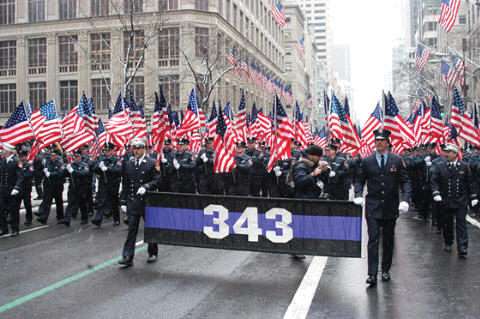
The annual parade down Fifth Avenue to honor the patron saint of Ireland is a New York tradition that dates as far back as 1766. The festivities kick off at 44th Street and Fifth Avenue at 11:00 am on March 17th, with bagpipers, high school bands, and the ever present politicians making their way up Fifth Avenue to 86th Street where the parade will probably finish around 4:30 or 5:00 pm.
The best viewing spots are toward the north end of the parade route, away from the shopping and work-a-day crowds that throng the sidewalks below 59th Street. Try sitting on the upper steps of the Metropolitan Museum of Art for a great view or catching a close-up view of the marchers where the parade turns east on 86th Street.
The New York Convention & Visitors Bureau says that the St. Patrick's Day Parade is the largest and most famous of the many parades held in the city each year.
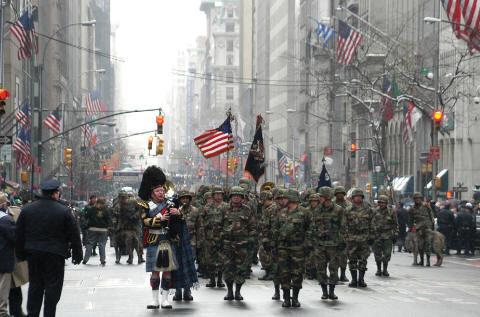
Colonial New York City hosted the first official St. Patrick's Day parade in 1762, when Irish immigrants in the British colonial army marched down city streets. In subsequent years Irish fraternal organizations also held processions to St. Patrick's Cathedral. The various groups merged sometime around 1850 to form a single, grand parade.
The parade marches up 5th Avenue, from 44th to 86th streets starting at 11am on St. Patrick's Day March 17th). It will probably be televised on NBC.
The Central Park transverse roads will stay open to traffic. Pedestrian crossing along the parade route will be allowed on 49th Street to 55th Street, 57th Street and 58th Street, 59th Street eastbound only and 60th Street westbound only.
